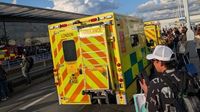Hundreds of travelers at London’s Heathrow Airport faced a dramatic and confusing evening on Monday, September 8, 2025, after a suspected tear gas incident forced the partial evacuation of Terminal 4. The episode, which unfolded just before 5pm, prompted a rapid response from emergency services, caused travel chaos for thousands, and led to the arrest of a 57-year-old man. While the incident was not considered terrorism-related, it sparked widespread disruption at Europe’s busiest airport, with the effects rippling through flight schedules and ground transport for hours.
According to BBC News, the trouble began around 17:00 BST when hundreds of people were ordered to leave the terminal. Passengers, airport workers, and emergency personnel alike found themselves caught in a situation that, at first, was shrouded in uncertainty. As the Metropolitan Police, London Fire Brigade, and London Ambulance Service converged on the scene, specialist officers in hazmat suits combed through the check-in area, searching for the source of what was described as a “potential hazardous materials incident.”
“No one really knew what was going on,” one witness told The Independent, echoing the confusion felt by many as they waited outside. Airport staff distributed foil blankets to delayed travelers as temperatures dropped, and crowds swelled outside the terminal. The London Fire Brigade reported being called at 5:01pm, dispatching crews from Feltham, Heathrow, Wembley, and surrounding stations.
After a thorough search, officers discovered a canister believed to contain CS spray—a synthetic irritant more commonly known as tear gas. The Metropolitan Police stated, “It is thought that this substance caused a reaction to those within the airport.” Around 20 people were treated by paramedics for irritation, but, as Sky News reported, none suffered life-threatening or life-changing injuries. The London Ambulance Service confirmed that one person was taken to hospital, while the rest were discharged at the scene.
CS spray, as explained by the UK Health Security Agency and cited by The Independent, is used by police forces as a temporary incapacitant to subdue individuals who may pose a risk. It can be dispersed in a smoke cloud or used in liquid form. While it is a tool for law enforcement, its possession is tightly regulated in Britain, where it is classified as a firearm.
Police quickly moved to secure the area and investigate the origins of the canister. By Tuesday, September 9, 2025, authorities had arrested a 57-year-old man on suspicion of possessing CS spray—considered a firearm under UK law—and causing a public nuisance. The suspect, whose name has not been released in line with English legal practice, remains in police custody as the investigation continues. The Metropolitan Police emphasized that the incident is “not being treated as terrorism-related.”
Scotland Yard added, “Following a search, officers had located a canister of what is believed to be CS spray. Around 20 people reported to paramedics after the (believed) CS spray caused irritation. It has been confirmed that the spray did not cause any life-changing or threatening injuries.”
For the hundreds caught up in the evacuation, the ordeal lasted nearly three hours. Passengers were allowed back into Terminal 4 shortly after 8pm, once the all-clear was given. Heathrow Airport, in a statement quoted by BBC News, said it was “very sorry for the disruption caused.”
Despite the scale of the evacuation, BBC News noted that disruption to flights landing and departing from Terminal 4 appeared minimal, according to flight data. However, The Independent reported that dozens of flights were delayed and thousands of travelers were affected, as the airport advised people not to travel to Terminal 4. National Rail said trains were unable to call at the terminal during the incident, compounding existing transport challenges already strained by London Underground strikes.
As the emergency unfolded, specialist teams in protective suits worked to ensure the safety of the terminal, and the crowds outside grew restless. Some passengers described feeling confused and anxious, uncertain about whether their flights would depart or when they would be allowed to re-enter. Airport staff did their best to keep people comfortable during the wait, handing out silver blankets and offering updates as information became available.
The investigation, led by the Metropolitan Police, is ongoing. Officers are working to determine how the CS spray canister came to be in Terminal 4 and whether any further charges will be brought against the suspect. While the police have ruled out terrorism, the incident has raised questions about airport security and the potential for similar substances to cause disruption in crowded public spaces.
CS gas, or 2-chlorobenzalmalononitrile, is a synthetic chemical that causes a burning sensation in the eyes and tearing, making it a potent irritant. In the UK, it is used by police as a last-resort tool to temporarily incapacitate individuals who pose a risk to themselves or others. The substance is also used by the military in training exercises and for testing gas masks. Its possession by civilians is strictly prohibited, and those found with it can face serious criminal charges.
Heathrow Airport, which just last month recorded its busiest day ever with more than 270,000 passengers passing through its terminals, has faced a series of challenges in recent months. Monday’s incident comes only months after a fire at an electrical substation forced the closure of the airport and the cancellation of 1,300 flights, according to The Independent. The latest disruption, however, was resolved more quickly, thanks in part to the coordinated response of emergency services and airport staff.
For now, the focus remains on supporting those affected and ensuring that Terminal 4 is safe for travelers and staff. The Metropolitan Police, in a statement to Sky News, reassured the public that “the incident is not being treated as terrorism related,” and that the suspect remains in custody as inquiries continue. The London Ambulance Service, for its part, confirmed that no one suffered serious harm, and the airport has since resumed normal operations.
As the dust settles, questions linger about how a canister of CS spray made its way into one of the world’s busiest airports and what steps can be taken to prevent similar incidents in the future. For the thousands whose journeys were delayed, the episode served as a stark reminder of the unpredictability of air travel—and the importance of swift, coordinated action in the face of potential danger.
With Terminal 4 reopened and the investigation ongoing, Heathrow’s travelers are once again moving through the gates, their stories from Monday night adding another chapter to the airport’s long and eventful history.






